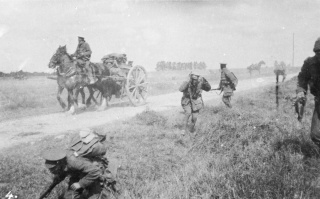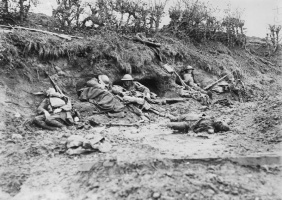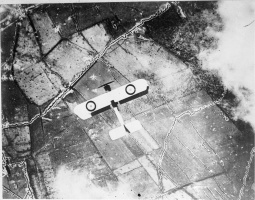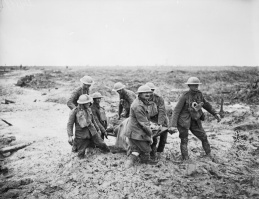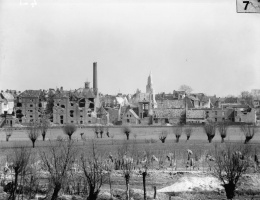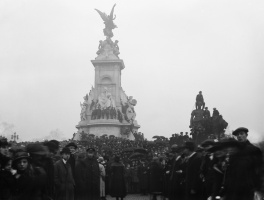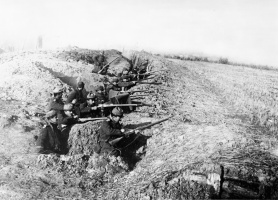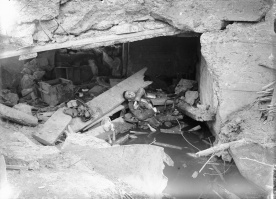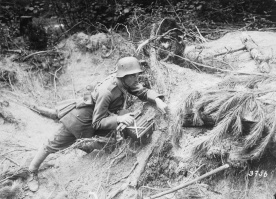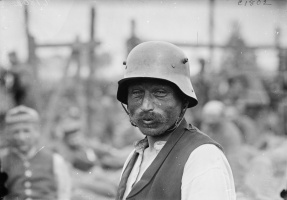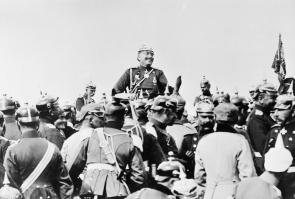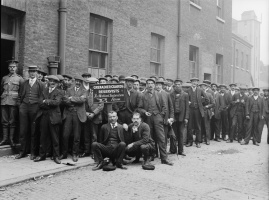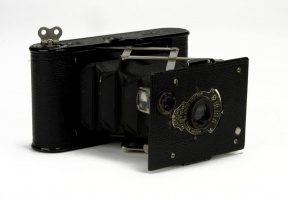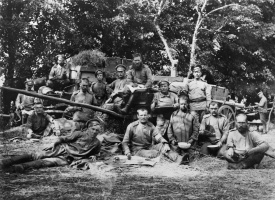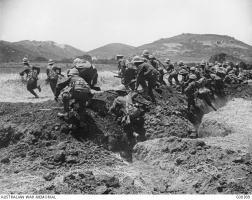Photography before the First World War↑
The world's first permanent photograph was created by Joseph Nicéphore Niépce (1765-1833) in France in 1825. By 1850, photography (a word adopted from the Greek term for “Drawing with Light”)[1] was practiced throughout the world. The new medium's ability to illustrate, interpret, influence and record, ensured that photographers were working in war zones and investigating photography's potential as a military tool as early as 1848. However primitive technology and the inability to reproduce photographs in printed publications prevented photography from being exploited as a mass medium until the late 19th century.
When Wilhelm II, German Emperor (1859-1941) ascended the German throne in 1888, photography was poised on the brink of major change. During the years that followed, improvements in technology transformed photography from a small specialist pursuit into a popular amateur hobby practiced by millions, and a thriving global commercial industry fed by a growing numbers of professional photographers. The development of the half tone printing process and the snapshot roll film camera played a crucial part in photography's transformation into a mass medium.
The half tone printing process[2] enabled publishers to reproduce photographs in newspapers, magazines and books. Public demand for illustrated publications fuelled the development of the professional photographic industry. Professional photographers (male and female) began to work, either on a freelance basis or as staff photographers, to supply a diverse range of established publications such as Illustrated London News (Britain, established 1842), L’Illustrazione Italiana (Italy, established 1873) or Niva (Russia, established 1870), as well as new outlets such as the Berliner Illustrierte Zeitung (Germany, established 1891) and The Sphere (Britain, established 1900). Publications exploring the potential of photography as art also appeared, the most notable being Alfred Stieglitz's (1864-1946) Camera Work (United States, established 1903). The burgeoning market for professional photography prompted the establishment of commercial picture agencies and other associations devoted to the promotion, management and dissemination of professional documentary and artistic photography in the years leading up to the First World War.
The development of amateur photography began in 1888, when George Eastman (1854-1932), an American inventor and businessman with a talent for astute marketing, introduced Kodak roll film cameras for amateur photographers. European camera manufacturers struggled to match Kodak's unique combination of simplicity, portability, clever design and value for money. A popular craze for photography ensued, led by European heads of state such as Albert I, King of the Belgians (1875-1934), Auguste Viktoria, Empress, consort of William II, German Emperor (1858-1921) and Alexandra, Queen, consort of Edward VII, King of Great Britain (1844-1925). By 1914, the term “Kodak” was synonymous with snapshot photography and an international infrastructure comprising organisations and publications for amateur photographers was operating alongside that for professionals.
Once launched, photography's transition to a mass medium progressed rapidly. However state and military infrastructures for the exploitation and control of photography failed to keep pace. The military potential of photography for reconnaissance and training purposes was certainly recognised and investigated. The British Army established a permanent service capability for such photography as early as 1856, and went on to develop considerable expertise in the use of field cameras (including those with panoramic and stereoscopic capability[3]) for military surveys, reconnaissance and artillery support. However military photography was not practiced on a large scale by any nation prior to the First World War. None of the major navies deemed it necessary to develop a significant service photographic capability either. Instead, they employed civilian photographers or delegated crew members with personal cameras as occasion required. However, the obvious potential of aerial photography did expedite the development of military aviation. With war imminent in June 1914, a photograph of British Army mobilisation trials at Netheravon taken by Sergeant Frederick Laws (1887-1975) of No 1 Squadron, Royal Flying Corps (see photograph), initiated the development of aerial photographic reconnaissance and interpretation; new military techniques which together would play a vital part in the war.
Official consideration of photography’s potential as a wartime tool for public information or propaganda, and the associated need to develop an infrastructure for the exploitation and control of such photography, was generally neglected. To some degree, this neglect was a consequence of the prevailing emphasis on the importance of literacy and the written word in 19th century Europe. Photographs were regarded as corroborative illustrations of the written word rather than influential artifacts in their own right. However the hostility of senior military and naval commanders towards publicity and the press was a more significant influence. The adverse experience of the Crimean War (1853-1856), which was the first war to be publicly reported in detail as events unfolded, had reinforced a general military aversion to wartime publicity and a reluctance to publish campaign information unless absolutely necessary. Graphic images showing American Civil War casualties after the Battle of Antietam in 1862, which were publicly exhibited in New York by Mathew Brady (1822-1896), strengthened a particular bias against photographers. Consequently, the practice of photography for propaganda and public information purposes was not included in the remit of military photographers while professional civilian photographers were barely tolerated either on the battlefield or on board ship. Field Marshal Lord Horatio Herbert Kitchener (1850-1916) (a particular opponent of journalists in general and photographers in particular) insisted that the "drunken squabs" should be kept at a distance during his Sudan campaign of 1879[4]. The international press corps covering the Turkish Army during the Balkan War of 1912: "were hedged about with so many restrictions and prohibitions that they were virtually prisoners."[5]
Kaiser Wilhelm II was exceptional in recognising the potential of photography as a propaganda medium. He developed a substantial complement of civilian official court photographers (of whom Oscar Tellgmann (1857-1936) is now best known) to generate a steady flow of carefully arranged images in support of the Kaiser's personality cult. The court photographers' official pictures of major military events, such as the Kaisermanöver[6] (see photograph), Imperial Fleet reviews and the widening of the Kiel Canal, formed one of the first iterations of a sustained photographic propaganda campaign and helped heighten international tensions in the years preceding the war.
Photography during 1914 - 1915↑
Photography's new status as a mass medium of visual communication was apparent in the events leading up to the outbreak of the First World War. Walter Tausch,[7] a local professional photographer, recorded the fatal visit of Franz Ferdinand, Archduke of Austria-Este (1863-1914) and his wife to Sarajevo in June 1914. Tausch's dramatic photographs of events surrounding the Royal couple's assassination (see photograph) were published around the world, strengthening public shock and outrage.
Professional and amateur photographers of every nationality and gender prepared to document events as war approached. The early wave of patriotic fervour that gripped Europe was extensively photographed by commercial press photographers. They documented the international transition to mass mobilisation and military training (see photograph) using medium format glass plate cameras optimised for press use, such as the Goerz Anschütz introduced in 1904 (see photograph A and photograph B). Their pictures found a ready market as the illustrated press rushed to launch special publications such as The War Illustrated (Britain) and Illustrierte Kriegs-Zeitung (Germany). Meanwhile soldiers, sailors and airmen included small personal cameras such as the Vest Pocket Kodak[8] (see photograph) in their kit, hoping to record a unique personal experience.
Hopes for detailed photographic coverage were quickly disappointed. Both the armed forces and the civilian authorities of the major belligerent powers adhered to pre-war policies and sought to limit photographers' access to events as much as possible. Britain’s chief naval censor, Rear-Admiral Sir Douglas Brownrigg (1867-1939) wrote:
Authorities were consistently reluctant to permit photography in the war zone for any non-military purpose and, while quick to acknowledge the value of written propaganda, were slow to recognise that of photography. Lord Kitchener, in his capacity as British Secretary of State for War, maintained his hostility to photographers of any description, barring civilian photographers of any nationality from working in the vicinity of the British Expeditionary Force on the Western Front, and threatening court martial for any serviceman caught carrying a personal camera. Fear of espionage ensured that civilian photographers working on the various home fronts were not exempt from control either. Professional documentary photographers required permits and were often restricted to working in designated areas. Even when they complied with regulations, photographers were vulnerable to arrest and harassment by state authorities.
Censorship of photography was introduced immediately. In Germany, censorship was controlled entirely by the military authorities. In other countries, such as Austria-Hungary, responsibility for censorship was divided between the military and civilian authorities. In authoritarian countries, such as Russia, where state control of the media was a given, wartime censorship did not make a great deal of difference to existing constraints on photographers. In countries accustomed to a free press, such as Britain, Canada and Australia, the new arrangements caused considerable frustration amongst photographers and publishers. However no country was fully prepared to deal with photography in its new incarnation as a mass medium. Photographers were hampered by the application of censorship procedures designed for the written word, while the censors themselves were almost overwhelmed by a flood of images with which they were not equipped to deal. Brownrigg noted: “It was no slight business keeping track of all the artistic and other efforts of those permitted to take photographs of naval objects."[10]
The exclusion of professional photographers from the war zone often forced European publishers to turn to pre-war stock photographs or graphic artists (who produced numerous dramatic, if often entirely imaginary, illustrations of battles and skirmishes) for images during this period. However, policies of exclusion and prohibition could not be consistently enforced in a conflict of this scale, even in the short term. Their efficacy was consistently undermined by a combination of overwhelming public demand for visual confirmation of heavily censored news reports and the lack of effective official infrastructures dedicated to photography. The Kaiser was one of the first to break military taboos on photographers when he authorised nineteen court photographers to accompany the German Army as it launched its assault on Belgium in August 1914. Albert K. Dawson (1885-1967), an American (and therefore neutral) photographer, was granted access to German forces on both the Western and Eastern fronts from December 1914 onwards. In Britain, newspaper owners quickly persuaded the Government to adopt a more relaxed approach to censorship in return for their agreement to voluntarily coordinate publication of war news with official requirements in September 1914.
The hard-pressed Belgian Army, desperate to garner international support, allowed Allied and neutral civilian press photographers considerable freedom to photograph their attempts to resist the German advance, which was also documented by the Kaiser's court photographers. The outcome was one of the first wartime demonstrations of the power of photography as propaganda. Patriotic photographers on both sides sought to emphasise the weakness of the Belgian Army in support of their opposing stances. Both highlighted the Belgian Army's outdated equipment, which included a heavy reliance on transport dogs (see photograph). German photographic coverage was intended for a domestic audience and sought to foster popular support for the Kaiser and the German Army. However its unsympathetic and triumphalist depiction of the Belgians did little to promote Germany overseas. Led by Charles Masterman (1873-1927), the newly established British War Propaganda Bureau was able to exploit the German photography to advantage. The British illustrated press supplemented their own coverage with German photographs obtained via neutral sources. A particularly shocking German photograph of the grave of a Belgian soldier (see photograph), obtained by the British Sport and General agency, was typical of photographs used to incite popular outrage in Britain and the United States over Germany's alleged treatment of the Belgians.
The failure to fully enforce military sanctions against servicemen with personal cameras was another consequence of ineffective official infrastructures. Instances of commanding officers authorising individual servicemen to use their cameras to create a semi-official record on behalf of their unit were common in 1914 and 1915.[11] The Kaiser authorised a relaxed approach to personal photography by German servicemen, provided they did not use cameras whilst in combat. Such tolerance enabled the Deutsche Gesellschaft der Photografie to conduct a successful appeal for snapshot cameras to be sent to German soldiers at the front in 1915. André Kertész (1894-1985) laid the foundations of his future career as a pioneering artistic photographer by taking personal photographs as a private in the Austro-Hungarian Army on the Eastern Front. Few Russian soldiers were able to afford personal cameras, but the vast distances of the Eastern Front meant that an effective ban could not be enforced on those that could.
Key events of 1914 and 1915 which could not be documented by military or civilian professional photographers were therefore recorded almost entirely in snapshots by soldiers, sailors and airmen.[12] Not surprisingly, photographs of actual combat were rare, but they were not completely unknown (see photograph). Graphic photographs of dead comrades were also rare, although there was less compunction about photographing enemy casualties. Women working as nurses documented the human cost of war as well as their own experiences. The photographs of Florence Farmborough (1887-1978), a British Red Cross nurse who worked with a Russian casualty clearing station on the Eastern Front, are a notable example (see photograph), as are those of Elsie Knocker (1884-1978) and Mairi Chisholm (1896-1981) who operated a frontline casualty post at Pervyse in the Belgian front line for most of the war.[13]
Frustrated by the inadequate supply of professional documentary photographs, the illustrated press actively encouraged servicemen to submit personal photographs for publication, often offering publication fees or mounting competitions. Publication of personal photographs had a mixed impact. In Germany, military censors ensured that the release of such photographs was tightly controlled and argued that the availability of such photographs rendered access by professional photographers unnecessary. Bodo von Dewitz notes:
More flexible censorship arrangements, combined with the offer of financial inducements, created problems in Britain and France. Snapshots of the controversial Christmas Truce of 1914 (see photograph) undermined attempts by British military authorities to downplay this event in the press. Even more seriously, prizes and financial rewards provided an incentive to submit photographs which had been manipulated or were otherwise of dubious authenticity. An accumulation of such problems compelled the British and French authorities to address the lax regulation of photography by servicemen at the front (British units were restricted to one camera each after April 1915), and to actively explore options for meeting the steadily escalating demand for documentary photographs of the war.
Military photographers were the only professional photographers consistently allowed to work on the front line in 1914 and 1915. Today, their photographs form a crucial record of the evolution of military defences and the impact of trench warfare on the landscape of the Western Front. Charged with documenting the battlefield and military equipment for operational purposes, army photographers produced ground based panoramic, stereoscopic and conventional views of the battlefields, particularly on the Western Front (see photograph), while air force photographers developed aerial photographic techniques in support of their reconnaissance role. Sgt. Frederick Laws took the first British photograph of German lines on the Western Front on 22 August 1914. Lieutenant Colonel J.T.C. Moore-Brabazon (1884-1964) designed the first practical aerial camera in early 1915. These innovations led in turn to the development of armed fighter aircraft and camouflage techniques:
The search for a means of satisfying press and public demand for documentary photographs, combined with the gradual, if belated, realisation of photography's potential as propaganda, forced the belligerent nations to consider the benefits of developing an official military photographic resource for press and propaganda material in 1915. The Austro-Hungarian Kriegspressequartier assumed responsibility for official photography, in addition to other media, at this time.[16] In April 1915, the French Army established the Section photographique de l'armée française (French Army Photographic Section) to take photographs for news, propaganda and the historical record (see photograph). Faced with a shortage of suitably trained photographers in uniform, the new section initially employed photographers supplied by leading commercial photographic firms, but quickly built up a substantial operation led by the noted autochromist, Major Jean-Baptiste Tournassoud (1866-1951), who personally took more than 800 colour photographs on the Western Front in addition to black and white photographs.
Winston Churchill (1874-1965), a former war correspondent, authorized Britain's first foray into such territory in his capacity as First Lord of the Admiralty and proposer of the Gallipoli Campaign. The Chief Naval Censor, Rear-Admiral Sir Douglas Brownrigg, was closely involved:
Brownrigg quickly established a basic routine for the censorship and distribution of photographs taken in Gallipoli by Ernest Brooks (1878-1941):
Brooks endured dangerous and difficult working conditions whilst covering the disastrous Gallipoli campaign. Undeterred by a shrapnel wound, he was widely praised for his courage and determination. An experienced freelance press and studio portrait photographer, he employed pre-war techniques to create striking photographs which consistently cast British and Australian troops in a heroic light, pleasing newspaper editors and the British Admiralty alike (see photograph). However, Brooks was constrained by limited resources and often resorted to stage management. This tactic was common amongst press photographers before the war, but its potentially damaging consequences rendered it inappropriate for an official war photographer. Charles Bean (1879-1968), Australian official correspondent in Gallipoli, was fiercely critical:
Stage management, or “faking”, also caused problems for commanders of the Indian Expeditionary Force, who appointed Dr Hilton DeWitt Girdwood (1878-1964) as their official photographer and cinematographer in late 1914. Girdwood was a Canadian photographer and operator of Realistic Travels, a commercial stereoscopic photograph publishing company. As a civilian, he was not permitted to photograph Indian troops on the front line of the Western Front and sought to compensate for this lack of access by using stage management and misleading attributions to create photographs of troops “in action”. The subsequent controversy involved two British government departments. Girdwood’s work consequently received very limited circulation during the war.
Photography during 1916 - 1918↑
The second half of the First World War saw a substantial increase in professional war photography as the belligerent nations established, extended or reconfigured professional resources for official documentary and propaganda photography on all fronts. These changes created a new demand for professional photographers. Many civilian press photographers were now serving with the armed forces but some, such as Lieutenant John Warwick Brooke (1886-1929) of Britain, were recommended for posts as official photographers by their peacetime employers, who were anxious for images which suited press requirements. France, Britain and Germany upgraded and expanded their existing propaganda operations to include the substantial and deliberate exploitation of official photography as a propaganda medium.
The development of official photography was accompanied by a corresponding reduction in opportunities for other forms of photography. The few commercial photographers not in uniform continued to be restricted to coverage of the home front, but even here official photographers were active in documenting the civilian war effort and received priority (see photograph). Amateur photography was increasingly curtailed, particularly on the Western Front. The practice of artistic photography was also curtailed and subjugated to the international war effort.
Britain and France, scarred by their experience of Gallipoli, now regarded victory on the Western Front as key to winning the war and configured their approach to official military photography accordingly. Formal training for aerial photography was introduced and the pool of photographers dedicated to military operational photography expanded considerably. The Royal Flying Corps established its School of Aerial Photography at Farnborough, Hampshire, in September 1916. Twelve months later, at the height of the British Flanders Offensive, photographic units of the Royal Flying Corps were able to produce nearly 15,000 aerial photographs in a single month.
In a separate initiative, an official military resource to take photographs for information and propaganda on a large scale was established at the British Army's general headquarters on the Western Front in early 1916. The supporting infrastructure for these new arrangements took some time to settle down:
In the spring of 1916, British and colonial official army photographers joined those of the French Army on the Western Front. Their first assignment was to cover the Somme Offensive. Ernest Brooks was the first British photographer to arrive. Following his successful coverage of the Gallipoli campaign, he was transferred to the British Army with a remit to cover the Western Front in early 1916 (see photograph). The Royal Navy found itself deprived of a resource which it had just begun to value, much to Rear-Admiral Brownrigg’s frustration:
The Royal Navy was not alone in struggling to find official photographers for publicity and propaganda work in the second half of the War. Press photography was still a young profession. The pool of professional photographers who possessed the necessary combination of skills and physical fitness was correspondingly small. Like the French in 1915, Britain and her Empire embraced official photography only to discover that suitable photographers were in short supply. The British Army could muster only two photographers[22] to cover its activities on the Western Front in 1916 and 1917. In such circumstances, limited coverage and prioritisation of propaganda material over the historical record was inevitable, as Jane Carmichael notes:
As Carmichael indicates, British official photography on the Western Front became increasingly graphic as time went on, reaching a climax in the battles of late 1917 and early 1918. This change in tone reflected a growing confidence in the public reaction to such material as well as a steady improvement in the coordination of propaganda by the new British Department of Information. The Department, led initially by John Buchan (1875-1940), was established in January 1917 with the active support and involvement of leading newspaper owners (such as Alfred Charles William Harmsworth, Lord Northcliffe (1865-1922) of the Daily Mail who was appointed Director of Propaganda for enemy countries). The Ministry of Information (as it became in 1918) ultimately gained overall responsibility for official photographers who were expected to adhere to Charles Masterman’s policy, which was known as the “Propaganda of the Facts”. Official photographs were required to inspire public confidence in their integrity while simultaneously undermining enemy morale and supporting an increasingly war weary public at home. In 1917, the British photographers combined graphic photographs of enemy dead (see photograph)and striking portraits of shabby, demoralised prisoners (see photograph) with photographs of stoic British troops carrying out their duties, regardless of conditions (see photograph).
British colonial forces, such as the Australian, New Zealand and Canadian expeditionary forces, relied heavily on British support for official photography on the Western Front. Four out of the seven colonial official photographers who covered the Western Front during this period were, in fact, British. The remit of the colonial photographers, like that of the French and British official photographers, was to take photographs for information, propaganda and the historical record. However their work reflects clear differences in the interpretation of this remit. The British photographers, of necessity, prioritized news and propaganda over that of record. The Australians, directed by Charles Bean in his capacity as official correspondent and historian, took great pains to create a detailed and truthful record for future generations. Hubert Wilkins (1888-1958), to whom Bean allocated "record work" in 1917, recorded graphic scenes that were unlikely ever to be used for wartime news or propaganda (see photograph). Frank Hurley (1885-1962), an Australian photographer with strong artistic instincts who worked on the Western Front in a press and propaganda role in late 1917, incurred Bean's disapprobation when he sought to explore the possibility of merging elements of different photographs for dramatic effect. Hurley recorded his frustration in his diary on 26 September 1917:
All Allied official photographers on the Western Front struggled with the contradictory requirements of publicity and the historical record:
The Canadian contribution was shaped by Max Aitken, Lord Beaverbrook (1879-1964). Beaverbrook juggled his role as head of Canadian War Records with those of a British newspaper proprietor, propagandist and politician. Throughout 1918, he served as British Minister of Information. Beaverbrook was not averse to courting controversy for the purpose of publicity or politics. As a result, Canadian photography of this period was firmly orientated towards raising awareness of the Canadian forces, employing techniques of stage management and even misattribution on occasion (see photograph). Ironically, this incurred the wrath of Ernest Brooks who complained bitterly about Canadian photographer William Ivor Castle (1877-1947) in December 1916:
Despite these issues, the press and propaganda impact of British and colonial official photography of the Somme offensive was considerable. Germany was compelled to make a similar transition in response and established the Militärische Film- und Fotostelle [Military Film and Photographic Unit] on 1 November 1916. Further rationalisation in support of a coordinated and pro-active domestic and overseas propaganda strategy quickly proved essential and was driven forward by the German Army's newly appointed Quartermaster General, General Erich von Ludendorff (1865-1937). In January 1917, the Bild- und Film Amt (Photograph and Film Department) was established to unite the functions of commissioning, production, management, censorship and dissemination of film and photography under the overall leadership of Oberstleutnant Hans von Haeften (1870-1937). From this point on, Germany's resources for official military photography and film dwarfed that of Britain. Every available trained photographer and cinematographer was drafted into the unit, which fielded seven mobile camera teams, each consisting of an officer, a film cameraman, a photographer and two orderlies (see photograph). Despite these resources, the Bild und Film Amt's overall effectiveness was undermined by the German Government's growing disunity. Ludendorff's appeal to establish a German Ministry of Propaganda to match that of Britain in early 1918 was disregarded. Consequently, the domestic and overseas impact of the official German photographic effort in support of publicity and propaganda never matched that of Britain and its colonies:
The pattern that emerges from these two, in a sense, parallel propaganda systems roughly mirrors the battlefield picture - in Britain a growing sense of purpose articulated through increasing coordination; and in Germany growing discord and, finally, disintegration.[27]
Political and military disintegration also played a part in Russia's failure to emulate other countries and develop a coherent official infrastructure for photography in support of information and propaganda. With the exception of the Tsar's court photographers, Russian photography of the First World War remained a private enterprise, conducted by commercial professional and amateur photographers, until 1917. Photographers such as Dobruinin, Miroshnicov and others attached to individual Russian military units, used a variety of cameras for operational, news and propaganda purposes. They documented the Russian Imperial Army on both the Eastern and Western Fronts (where a contingent of Russian troops served in support of the French Army). Publication of their photographs by state controlled media outlets was limited and tightly controlled, reaching an audience which represented a small proportion of the Russian people and receiving very limited circulation overseas. This record, and Russia's participation in the war, came to an abrupt end with the Revolution of 1917, which itself was photographed by Viktor Bulla (1883-1938), a commercial photographer of the St Petersburg photographic firm Bulla and Sons.
When the United States entered the war in 1917, it had the advantage of being able to learn from the considerable experience accumulated by its Allies with regard to photography. The United States Signal Corps were the designated military official photographers of the US Army with a remit which covered documentary, propaganda and operational photography. Mastering the specialist requirements of operational photography was an immediate priority. United States Air Force photographers received preliminary instruction in aerial photography from their British counterparts. However George Eastman moved quickly to offer Kodak’s services:
Eastman established the United States School of Aerial Photography at Kodak Park in Rochester, New York in March 1918, and maintained it there until the end of the war. With facilities for a thousand students and access to distinguished Kodak research scientists, such as Dr Kenneth Mees (1882-1960), the School was by far the largest and most sophisticated establishment of its kind during the First World War. 2,177 students completed six week training courses during the ten months of the School’s existence. The US Air Force photographic branch, led by Major Edward Steichen (1879-1973)[29], operated briefly on a similarly large scale, generating 17,000 prints a day during the final battles on the Western Front.
In many respects, American documentary and propaganda photography adhered to the models established by Britain and France. However the Commander of the American Expeditionary Forces, General John J. Pershing (1860-1948), had a more flexible attitude towards civilian professional photographers in the war zone compared to that of British and French commanders. With his authorisation, civilian press photographers were granted supervised access to US troops on the Western Front as the tide of war turned in the Allies’ favour in 1918.
All sides exercised strict controls on amateur photography on the Western Front during this period. However the controls were more lax in the remoter theatres of war. An acute shortage of professional official photographers ensured that servicemen's snapshots continued to play an important role in documenting conflicts in Salonika, Mesopotamia, Egypt and Palestine. These photographs often combined conflict with elements of tourism. Janina Struk writes of the Middle East:
One of the most important compilations of personal photographs is that created by Colonel Thomas Edward Lawrence (1888-1935) and other British officers who used personal cameras to photograph the Arab Rebellion (see photograph). Commander O. S. Locker-Lampson (1880-1954) also compiled photographs relating to the operations of his naval armoured cars in Russia, Persia and Turkey.
When the First World War finally ended on 11 November 1918, official, commercial and snapshot photographers were in place to document it, responding to the moment with photographs that were often overtly symbolic in their realisation. Anne Wilkes Tucker notes:
Coverage was generally celebratory in Allied countries, but some photographers, such as Christina Broom (1862-1939) of Britain, captured a more sombre mood (see photograph). French photographers documented the formal signing of the Armistice in General Ferdinand Foch’s (1851-1929) railway carriage at Compiègne in a humiliating scene which would be deliberately restaged for the camera by the Germans following the Fall of France in 1940. Such humiliation was also reflected in the only known photograph of the Kaiser at this time: a snapshot taken as he left Germany for exile in the Netherlands (see photograph). Equally symbolic was the German official photographers’ coverage of German troops returning home to a ceremonial welcome, in which they were clearly presented as an undefeated force despite having been forced to abandon their weapons.
In contrast to the extensive international coverage of mobilisation in 1914, there was relatively little interest in documenting the demobilisation of the largest armies ever assembled. This was partly due to the rapid dismantling of the official wartime apparatus for photography. For countries with a tradition of non-authoritarian governments and a free press, such infrastructures were at once a wartime necessity but a peacetime anathema. In response to political pressure, the British Government rushed to close the Ministry of Information and transferred its responsibilities to the Imperial War Museum on 1 January 1919. Such was the haste that the museum found itself appointed employer of the British official photographers, who were engaged in accompanying the British Army as it moved to occupy German territory. France, Germany and Austria-Hungary likewise dismantled their wartime arrangements for photography. Those photographers who remained in the former war zones were briefly employed with documenting the battlefields and the creation of cemeteries before returning home to civilian life.
The lack of photographs showing demobilisation also reflects the public mood of extreme war fatigue, social and political upheaval (particularly in Central Europe and the Middle East) and the imperative to focus on post-war recovery. Photographs of commemoration and remembrance were the exception. The construction and dedication of memorials, such as the British Tomb of the Unknown Warrior (see photograph) during the immediate post-war years, forms a final poignant chapter in the photography of the First World War.
Conclusion↑
War photography as a genre came of age during the First World War. Despite many constraints and limitations, professional and amateur photographers of all nationalities combined to create a significant body of work which informed public understanding during the war itself. In subsequent years, further photographs, unpublished in wartime, have served to fuel debate, shape perceptions and inform contemporary understanding of the War. Although infrastructures for the exploitation and management of photography were dismantled at the end of the war, precedents (such as the need to manage rather than prohibit frontline access for photographers) had been set, and the value of photography, particularly as a powerful medium of mass communication, clearly established. In a very real sense, the First World War not only laid the foundations for photography during the Second World War, but for every conflict since.
Archives of First World War Photography↑
Significant collections of First World War photography and/or associated documents are held by the following institutions (see the external links for this article):
- Australian War Memorial, Canberra, Australia
- Austrian National Library, Vienna, Austria
- Das Bundesarchiv, Koblenz (Bildarchiv), Germany
- George Eastman House, Rochester, New York, United States
- Historial de la Grande Guerre, Peronne, France
- Imperial War Museum, London, Britain
- National Library and Archives, Ottawa, Canada
- Library of Congress, Washington DC, United States
- The National Archives, Kew, London, Britain
- Russian State Documentary Film and Photograph Archive, Krasnogorsk, Russia
Hilary Roberts, Imperial War Museum
Section Editors: Dominik Geppert; David Welch
Notes
- ↑ The term "Photography" was devised by Sir John Herschel (1792-1871), a British scientist, in 1839.
- ↑ The half tone printing process is a technique by which an image is broken up into a series of dots to reproduce the full tonal range of a photograph. It was developed by Frederic Ives (1856-1937), Georg Meisenbach (1841-1912) and others from 1880 onwards.
- ↑ Panoramic photography involves generating an image, usually landscape, with an elongated field of view by either merging a sequence of individual photographs or by making a single exposure using a camera with a rotating lens. Stereoscopic photography involves creating an image with the illusion of depth by simulating the binocular vision of the human eye. Both techniques were used regularly during the First World War.
- ↑ Farish, Matthew: Modern Witnesses: foreign correspondents, geopolitical vision, and the First World War, in: Transactions of the Institute of British Geographers, New Series 26/3 (2001), p. 280.
- ↑ Baldwin, Herbert F.: A War Photographer in Thrace, London & Leipzig 1913, pp. 8–9.
- ↑ The Imperial German Army’s elaborate annual military manoeuvres, which took place every summer in the presence of Kaiser Wilhelm II, were designed to present Germany as a modern military power.
- ↑ Walter Tausch was an Austrian photographer who moved to Sarajevo on behalf of the Austro-Hungarian government in 1910 and opened a studio entitled “Photographische Kunstanstalt Sarajevo, neben Apollotheater” in Kulovica Street. He was one of the few Austrians to remain in Sarajevo after the War.
- ↑ Kodak introduced the Vest Pocket Kodak in 1912, marketing it as “The Soldier’s Camera” in 1915. Sales of nearly two million cameras made it one of the most popular cameras of its era.
- ↑ Brownrigg, Rear-Admiral Sir Douglas: Indiscretions of the Naval Censor, London, New York, Toronto and Melbourne 1920, p. 9.
- ↑ Brownrigg, Sir Douglas 1920, p. 15.
- ↑ Particularly notable examples of such photographic records include those compiled by Sergeant Christopher Pilkington (2nd Scots Guards, BEF), Major Robert Money (1st Cameronians, BEF), Commander S. G. Andrews (HMS Kent, Royal Navy), Lt. Gustav Lachman (Leib-Dragoner-Regiment No 24, IGA), Paul Lucien Maze (French Army) and C. E. W. Bean (Australian official correspondent), all preserved by the Imperial War Museum, London.
- ↑ Events of 1914 and 1915 that were recorded in detail by soldiers using personal cameras include the retreat from Mons, early fighting in the Ypres Salient, the evolution of trench warfare on the Western Front, the Russian retreat from Poland, the African campaigns, naval actions, such as the Battle of the Falkland Islands, and the Gallipoli campaign.
- ↑ The collections of Florence Farmborough, Elsie Knocker and Mairie Chisholm are preserved by the Imperial War Museum, London.
- ↑ Dewitz, Bodo von: German Snapshots from World War 1. Personal Pictures, Political Implications, in: Tucker, Anne Wilkes/Michels, Will/Zelt, Natalie (eds.), War/Photography. Images of Armed Conflict and Aftermath, New Haven 2012, p. 154.
- ↑ Payne, David: The Genesis of Aerial Reconnaissance on the Western Front in the Great War, issued by The Western Front Association, online: http://www.westernfrontassociation.com/great-war-at-sea-in-air/aerial-warfare/59-aerial-reconaissance-.html (retrieved 20 July 2013).
- ↑ Austro-Hungarian official photographers took at least 33,000 photographs during the First World War.
- ↑ Brownrigg: Sir Douglas, 1920, p. 14.
- ↑ Brownrigg: Sir Douglas, 1920, pp. 15.
- ↑ Bean, C.E.W, Diary, 2 June 1916, p. 64 issued by Australian War Memorial, online: [1] (retrieved 23 September 2016).
- ↑ Carmichael, Jane: First World War Photographers, London & New York, 1989, pp. 47-48.
- ↑ Brownrigg, Sir Douglas, 1920, p. 14.
- ↑ As a British Army official photographer, Lieutenant Ernest Brooks alternated between the Western and Italian Fronts (in addition to occasional assignments for the Admiralty) from June 1916 until the end of the War. He shared coverage of the Western Front with Lieutenant John Warwick Brooke, a former press photographer, who was appointed British Army official photographer in July 1916.
- ↑ Carmichael, First World War Photographers, 1989, pp. 63-64.
- ↑ Dixon, Robert/Lee, Christopher (eds.): The Diaries of Frank Hurley, 1912-1941, London 2011, pp. 72.
- ↑ Carmichael: First World War Photographers, 1989, p. 74.
- ↑ Imperial War Museum, London (Photograph Archive): War Propaganda Bureau/Ministry of Information Wellington House Papers 1914 – 1919, unpublished letter from Ernest Brooks to Ivor Nicholson 12 December 1916.
- ↑ Goldfarb Marquis, Alice: Words as Weapons: propaganda in Britain and Germany during the First World War, in: Journal of Contemporary History, 13/3 (1978), p. 475.
- ↑ George Eastman House, Rochester, New York (George Eastman Archive and Study Center): First World War photography, papers, publications and photographic technology relating to George Eastman and the Kodak Company during the First World War, unpublished letter from George Eastman to M B Philipp, 20 May 1918.
- ↑ Edward Steichen, a noted American artist, photographer and curator, worked closely with Alfred Stieglitz on Camera Work and was an early proponent of the pictorialist movement before the First World War. He was also an early pioneer of fashion photography.
- ↑ Struk, Janina: Private Pictures: Soldiers’ Inside View of War, London & New York 2011, p. 54.
- ↑ Wilkes Tucker, Anne: War’s End, in: Tucker, Anne Wilkes/Michels, Will/Zelt, Natalie (eds.): War/Photography. Images of Armed Conflict and Aftermath, New Haven 2012, p. 489.
Selected Bibliography
- Brownrigg, Douglas Egremont Robert: Indiscretions of the naval censor, London; New York 1920: Cassell and Co.
- Carmichael, Jane: First World War photographers, London; New York 1989: Routledge.
- Dawson, Albert K.: Photographing on the firing line, in: Photo-Era. The American Journal of Photography 38, 1917, pp. 232-234.
- Dopperen, Ron van: Shooting the Great War. Albert Dawson and the American Correspondent Film Company, 1914-1918, in: Film History 4/2, 1990, pp. 123-129.
- Farish, Matthew: Modern witnesses. Foreign correspondents, geopolitical vision, and the First World War, in: Transactions of the Institute of British Geographers 26/3, 2001, pp. 273-287.
- Guillot, Hélène: La section photographique de l’armée et la Grande Guerre, in: Revue historique des armées 258, 2010, pp. 110-117.
- Holborn, Mark / Roberts, Hilary (eds.): The Great War. A photographic narrative, London 2013: Imperial War Museum; Jonathan Cape; Knopf.
- Holzer, Anton: Die andere Front. Fotografie und Propaganda im Ersten Weltkrieg. Mit unveröffentlichten Originalaufnahmen aus dem Bildarchiv der Österreichischen Nationalbibliothek, Darmstadt 2007: Primus.
- Hurley, Frank, Dixon, Robert / Lee, Christopher (eds.): The diaries of Frank Hurley, 1912-1941, London 2011: Anthem Press.
- Keller, Ulrich: Der Weltkrieg der Bilder. Organisation, Zensur und Ästhetik der Bildreportage 1914-1918, in: Fotogeschichte 130, 2013, pp. 5-50.
- Keller, Ulrich: Verdun, 1916. Die Schlacht der Bildreportagen, in: Fotogeschichte 130, 2013, pp. 51-84.
- Lacaille, Frédéric / Petiteau, Anthony: Photographies de poilus. Soldats photographes au cœur de la grande guerre. Collections photographiques du Musée de l'Armée, Paris 2004: Somogy.
- Lakin, Shaune A.: Contact. Photographs from the Australian War Memorial collection, Canberra 2006: Australian War Memorial.
- Ministère de la guerre / Section photographique de l'armée: Ministère de la guerre, Section photographique de l'armée 1917. Documents de la Section photographique de l'Armée française, Paris 1917: E. Paul.
- Paul, Gerhard: Bilder des Krieges, Krieg der Bilder. Die Visualisierung des modernen Krieges, Paderborn; Munich 2004: Schöningh; Fink.
- Roberts, Hilary: Der weibliche Blick. Britinnen fotografieren im Ersten Weltkrieg, in: Fotogeschichte 134/34, 2014.





